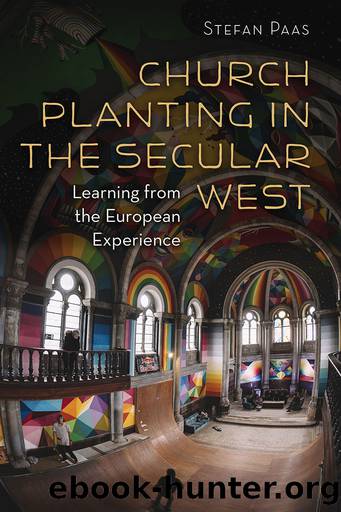Church Planting in the Secular West by Paas Stefan;

Author:Paas, Stefan;
Language: eng
Format: epub
Publisher: William B. Eerdmans Publishing Company
This shows, at least, that only a quarter or so of all newcomers (8-9% of all visitors) are people who did not attend a church before, at least for a while. If we limit our head-count to people who can be expected to have a predominantly non-churched background (first-timers), this number drops further to approximately 2% of the overall attendance. Of course, in churches that have above-average rates of newcomers (that is, more than 33%), this percentage may be largerâassuming that the portion of first-timers remains the same. So, if a church has 50% newcomers, and 7% of them are first-timers, the last group will make up 3.5% of its attendance (plus 9-10% returnees). Nevertheless, these are sobering results compared to the many sweeping statements that are being made on the basis of baptism-counts.
If young churches generally grow more often and faster than older churches, this may indicate that they are moderately more successful in terms of conversion growth. Of course, in church plants the attendance will consist entirely of newcomers (leaving aside the launch group), so this means that first-timers will occupy around 7% of their attendance, and returnees another 18% (whereas 75% of its membership will consist of transfers and switchers). However, this is only hypothetically true. It may very well be that the proportion of first-timers is not stable. This is suggested by other data from the PCUSA. Interestingly, they show that the number of first-timers and returnees in younger PCUSA congregations is lower than in older congregations.90
New people in churches founded: between 1993 and 2008 (n=938) before 1993 (n=18,226)
First-timers 6% 8%
Returnees 11% 17%
Switchers 18% 22%
Transfers 65% 52%
From this table it appears that church plants in the PCUSA draw the large majority (83%) of their attendees from switchers and transfers. This confirms an older observation by David Roozen and Kirk Hadaway that the number of people who have recently migrated into the area was 2-3 times as high in younger churches as compared to older churches.91 It is a surprising result, to say the least, even if we must take into account that the number of people in both groups is very unequal (938 and 18,226), that the percentage differences are not dramatic, and that these figures apply to only one denomination. This can easily cause misrepresentations. Nevertheless, the best research available (even if it is still quite limited) suggests that there is no convincing relationship between the age of a church and its growth or its conversion success in the United States.
Probably, location is more important than age. The Facts on Growth report (2005) shows, for example, that churches in newer suburbs or (more surprisingly) in downtown areas were most likely to grow. Their growth opportunities are heavily influenced by demographics. The recent moves toward urban renewal and gentrification clearly form an opportunity for central city churches. There are simply many more people moving in today than some decades ago.92 If this knowledge is of any strategic value, it suggests that church planting is a good way for denominations to stay in tune with demographic currents.
Download
This site does not store any files on its server. We only index and link to content provided by other sites. Please contact the content providers to delete copyright contents if any and email us, we'll remove relevant links or contents immediately.
Joan of Arc by Mary Gordon(3271)
Victory over the Darkness by Neil T. Anderson(2390)
The Gnostic Gospels by Pagels Elaine(2034)
Devil, The by Almond Philip C(1906)
The Nativity by Geza Vermes(1853)
The Psychedelic Gospels: The Secret History of Hallucinogens in Christianity by Jerry B. Brown(1829)
Going Clear by Lawrence Wright(1575)
Going Clear: Scientology, Hollywood, and the Prison of Belief by Lawrence Wright(1574)
Barking to the Choir by Gregory Boyle(1509)
A TIME TO KEEP SILENCE by Patrick Leigh Fermor(1501)
Old Testament History by John H. Sailhamer(1499)
Augustine: Conversions to Confessions by Robin Lane Fox(1475)
A History of the Franks by Gregory of Tours(1402)
The Knights Templar by Sean Martin(1399)
A Prophet with Honor by William C. Martin(1376)
The Bible Doesn't Say That by Dr. Joel M. Hoffman(1374)
by Christianity & Islam(1351)
The Amish by Steven M. Nolt(1254)
The Time Traveler's Guide to Medieval England by Ian Mortimer(1219)
